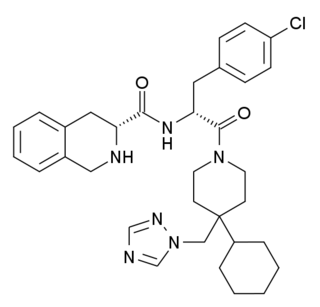
The dopamine receptor D4 is a dopamine D2-like G protein-coupled receptor encoded by the DRD4 gene on chromosome 11 at 11p15.5.

Aporphine is an alkaloid with the chemical formula C17H17N. The IUPAC name of aporphine is 6-methyl-5,6,6a,7-tetrahydro-4H-dibenzo[de,g]quinoline. It is the core chemical substructure of the aporphine alkaloids, a subclass of quinoline alkaloids. It can exist in either of two enantiomeric forms, (R)-aporphine and (S)-aporphine.

SB-277,011A is a drug which acts as a potent and selective dopamine D3 receptor antagonist, which is around 80-100x selective for D3 over D2, and lacks any partial agonist activity.

Dopamine receptor D1, also known as DRD1. It is one of the two types of D1-like receptor family - receptors D1 and D5. It is a protein that in humans is encoded by the DRD1 gene.

Dopamine receptor D3 is a protein that in humans is encoded by the DRD3 gene.

The 5-HT7 receptor is a member of the GPCR superfamily of cell surface receptors and is activated by the neurotransmitter serotonin (5-hydroxytryptamine, 5-HT) The 5-HT7 receptor is coupled to Gs (stimulates the production of the intracellular signaling molecule cAMP) and is expressed in a variety of human tissues, particularly in the brain, the gastrointestinal tract, and in various blood vessels. This receptor has been a drug development target for the treatment of several clinical disorders. The 5-HT7 receptor is encoded by the HTR7 gene, which in humans is transcribed into 3 different splice variants.

Pozanicline is a drug developed by Abbott, that has nootropic and neuroprotective effects. Animal studies suggested it useful for the treatment of ADHD and subsequent human trials have shown ABT-089 to be effective for this application. It binds with high affinity subtype-selective to the α4β2 nicotinic acetylcholine receptors and has partial agonism to the α6β2 subtype, but not the α7 and α3β4 subtypes familiar to nicotine. It has particularly low tendency to cause side effects compared to other drugs in the class, making it an exciting candidate for clinical development.
An H3 receptor antagonist is a classification of drugs used to block the action of histamine at the H3 receptor.

THIQ is a drug used in scientific research, which is the first non-peptide agonist developed that is selective for the melanocortin receptor subtype MC4. In animal studies, THIQ stimulated sexual activity in rats, but with little effect on appetite or inflammation. This supports possible application of MC4 selective agonists for the treatment of sexual dysfunction in humans, although THIQ itself has poor oral bioavailability and a short duration of action so improved analogues will need to be developed.

6-Br-APB is a synthetic compound that acts as a selective D1 agonist, with the (R)-enantiomer being a potent full agonist, while the (S) enantiomer retains its D1 selectivity but is a weak partial agonist. (R)-6-Br-APB and similar D1-selective full agonists like SKF-81,297 and SKF-82,958 produce characteristic anorectic effects, stereotyped behaviour and self-administration in animals, with a similar but not identical profile to that of dopaminergic stimulants such as amphetamine.

7-OH-DPAT is a synthetic compound that acts as a dopamine receptor agonist with reasonable selectivity for the D3 receptor subtype, and low affinity for serotonin receptors, unlike its structural isomer 8-OH-DPAT. 7-OH-DPAT is self-administered in several animal models, and is used to study addiction to cocaine.

A-86929 is a synthetic compound that acts as a selective dopamine receptor D1 agonist. It was developed as a possible treatment for Parkinson's disease, as well as for other applications such as treatment of cocaine addiction, but while it had reasonable efficacy in humans it also caused dyskinesias and has not been continued. It has mainly been used as its diacetate ester prodrug adrogolide (ABT-431), which has better bioavailability.

Dinapsoline is a drug developed for the treatment of Parkinson's disease, that acts as a selective full agonist at the dopamine D1 receptor.

Arylcyclohexylamines, also known as arylcyclohexamines or arylcyclohexanamines, are a chemical class of pharmaceutical, designer, and experimental drugs.

PF-219,061 is a drug that was under development by Pfizer which acts as a potent and highly selective agonist for the dopamine D3 receptor. It was under development as a potential medication for the treatment of female sexual dysfunction. It did not advance into clinical trials.

ABT-670 is a drug which acts as a potent, orally bioavailable dopamine agonist selective for the D4 subtype, which was developed as a possible treatment for erectile dysfunction, although its current uses are limited to scientific research.

BRL-52537 is a drug which acts as a potent and highly selective κ-opioid agonist. It has neuroprotective effects in animal studies, and is used for research into potential treatments for stroke and heart attack as well as more general brain research.

5-OH-DPAT is a synthetic compound that acts as a dopamine receptor agonist with selectivity for the D2 receptor and D3 receptor subtypes. Only the (S)-enantiomer is active as an agonist, with the (R)-enantiomer being a weak antagonist at D2 receptors. Radiolabelled 11C-5-OH-DPAT is used as an agonist radioligand for mapping the distribution and function of D2 and D3 receptors in the brain, and the drug is also being studied in the treatment of Parkinson's disease.

PF-00446687 is a drug developed by Pfizer for the treatment of erectile dysfunction, which is a non-peptide agonist selective for the melanocortin receptor subtype MC4. It was found to be active in preliminary human trials, with the 200mg dose being of similar effectiveness to 100mg sildenafil, though lower doses were ineffective.

PF-592,379 is a drug developed by Pfizer which acts as a potent, selective and orally active agonist for the dopamine D3 receptor, which is under development as a potential medication for the treatment of female sexual dysfunction and male erectile dysfunction. Unlike some other less selective D3 agonists, a research study showed that PF-592,379 has little abuse potential in animal studies, and so was selected for further development and potentially human clinical trials. Development has since been discontinued.



















